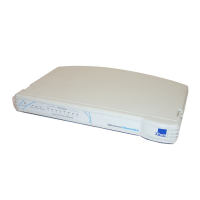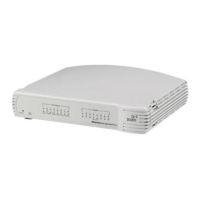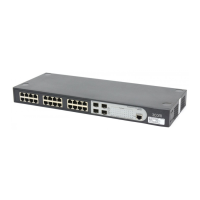218 APPENDIX B: DEVICE SPECIFICATIONS AND FEATURES
LACP LACP uses peer exchanges across links to determine, on an ongoing basis,
the aggregation capability of various links, and continuously provides the
maximum level of aggregation capability achievable between a given pair
of systems. LACP automatically determines, configures, binds and
monitors the port binding within the system.
Link Aggregated Groups The system provides up to four Link Aggregated Groups (LAGs).
Aggregated Links may be defined, each with up to eight member ports,
to form a single LAG. LAGs provide:
■ Fault tolerance protection from physical link disruption
■ Higher bandwidth connections
■ Improved bandwidth granularity
■ High bandwidth server connectivity
■ LAG is composed of ports with the same speed, set to full-duplex
operation.
MAC Address Capacity Support The device supports up to 8K MAC addresses. The device reserves specific
MAC addresses for system use.
MAC Multicast Support Multicast service is a limited broadcast service, which allows one-to-many
and many-to-many connections for information distribution. Layer 2
Multicast service is where a single frame is addressed to a specific
Multicast address, from where copies of the frame are transmitted to the
relevant ports.
MDI/MDIX Support The device automatically detects whether the cable connected to an RJ-45
port is crossed or straight through, when auto-negotiation is enabled.
Standard wiring for end stations is Media-Dependent Interface (MDI) and
the standard wiring for hubs and switches is known as Media-Dependent
Interface with Crossover (MDIX).
Password Management Password management provides increased network security and improved
password control. Passwords for HTTP, HTTPS, and SNMP access are
assigned security features. For more information on Password
Management, see
“Default Users and Passwords” page 29.
Port-based Authentication Port-based authentication enables authenticating system users on a
per-port basis via an external server. Only authenticated and approved
system users can transmit and receive data. Ports are authenticated via
the Remote Authentication Dial In User Service (RADIUS) server using the
Extensible Authentication Protocol (EAP).
Port-based Virtual LANs Port-based VLANs classify incoming packets to VLANs based on their
ingress port.
Port Mirroring Port mirroring monitors and mirrors network traffic by forwarding copies
of incoming and outgoing packets from a monitored port to a monitoring
port. Users specify which target port receives copies of all traffic passing
through a specified source port.
Table 9 Features of the OfficeConnect Managed Gigabit PoE Switch (continued)
Feature Description

